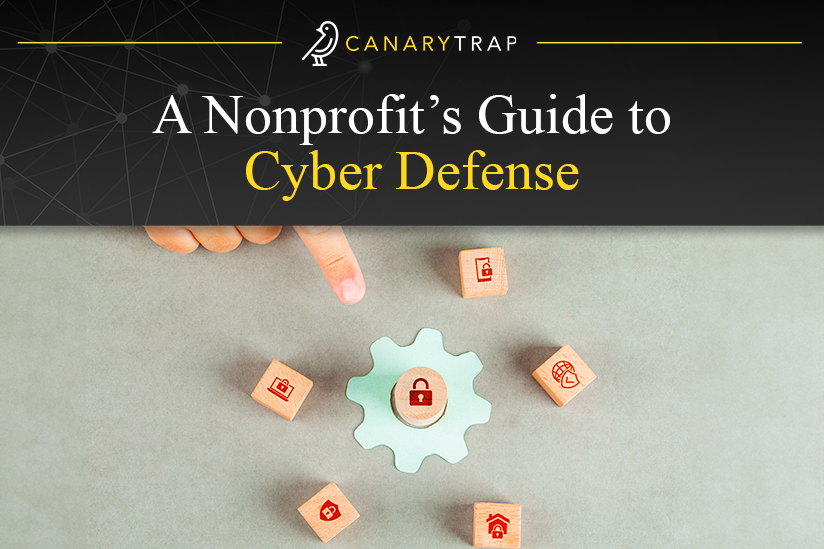A Nonprofit’s Guide to Cyber Defense
- June 21, 2024
- Canary Trap
In today’s digital age, cybersecurity is a critical concern for all organizations, including nonprofits. While nonprofits may not have the same financial resources as large corporations, they hold valuable data, including donor information, financial records, and sensitive client data. Cybercriminals are increasingly targeting these organizations, knowing that they often lack the robust security measures of their for-profit counterparts. A single data breach can have devastating consequences, leading to financial loss, reputational damage, and a loss of trust from donors and beneficiaries.
At Canary Trap, we believe that the importance of cybersecurity for nonprofits cannot be overstated. As these organizations often operate on tight budgets and rely heavily on public trust and goodwill, a cybersecurity incident can jeopardize their mission and existence. With the rise of digital transformation, more nonprofits are adopting technology to improve their operations, fundraising, and service delivery. However, this increased reliance on digital tools also opens up new avenues for cyber threats.
In this blog, we aim to provide nonprofits with a comprehensive guide to protecting their valuable data. We will explore the current cybersecurity threat landscape, identify the types of data that nonprofits hold and why it is attractive to cybercriminals, and outline both basic and advanced cybersecurity measures that organizations can implement. Additionally, we will discuss the importance of collaborating with IT professionals and cybersecurity experts to enhance security efforts. Canary Trap’s goal is to help nonprofit leaders have a clearer understanding of the steps they need to take to safeguard their organizations against cyber threats and ensure the continued trust and support of their communities. Investing in cybersecurity is not just about protecting data; it’s about safeguarding the integrity and future of the nonprofit’s mission.
Understanding the Cybersecurity Threat Landscape
Despite their altruistic missions, nonprofits are not immune to the ever-evolving landscape of cyber threats. These organizations face a myriad of virtual risks that can compromise their operations and erode the trust of their donors and beneficiaries.
As pointed out in an article by Computers Nationwide, “No matter the generation, most donations are now made online via websites, social media, fundraising platforms, and more. Online channels are the key messaging platforms that nonprofits use to advertise their causes and collect funds.” However, “with so many links and digital platforms involved, cybercriminals are lurking right around the corner ready to attack,” they continue.
Common cyber threats include phishing attacks, ransomware, and data breaches. Phishing attacks, where cybercriminals trick individuals into divulging sensitive information, are particularly prevalent and often target nonprofit employees who may not be as vigilant about cybersecurity. On the other hand, ransomware attacks, which involve malicious software that encrypts an organization’s data until a ransom is paid, can be devastating for nonprofits, potentially halting their operations and causing significant financial strain.
Understanding these threats is the first step in developing an effective cybersecurity strategy. Nonprofits must recognize that their valuable data makes them attractive targets for cybercriminals. Data such as donor information, financial records, and sensitive client details are highly sought after in the black market and exploited by cybercriminals for identity theft, financial fraud, or disrupting the nonprofit’s operations.
According to Nonprofits Decoded, “Hacks aren’t always obvious and evident. Some hacks are subtle. They can come in the form of malware, suspicious activity, denial of service, phishing, SQL, and more.” Other threats include forced downtime, which may not seem as dangerous as stealing data, “but it can still heavily compromise […] the operations of your nonprofit, for example, by throwing your website hosting offline. This may result in missing donations, making information harder to access or impacting volunteer scheduling.”
By being aware of the common threats and understanding the potential impact of cyber attacks, nonprofits can better prepare themselves and implement proactive measures to protect their data. This involves not only investing in the right technologies, such as Canary Trap’s cybersecurity services, but also fostering a culture of cybersecurity awareness among employees and volunteers. Only through a comprehensive approach can nonprofits hope to mitigate the risks posed by the current cybersecurity threat landscape.
Identifying Valuable Data in Nonprofits
Nonprofits manage a variety of sensitive data, making them attractive targets for cybercriminals. Understanding the types of data they hold and why it’s valuable is crucial for implementing effective cybersecurity measures.
- Donors Personal Information
Nonprofits often store extensive donor information, including names, addresses, phone numbers, and email addresses. This data can also include payment information, which, if compromised, could lead to financial fraud and identity theft. Donor lists are particularly valuable to cybercriminals because they can be sold on the black market or used to execute targeted phishing campaigns.
- Financial Records
Financial records are another critical data type held by nonprofits. These records include bank account details, transaction histories, payroll information, and grant allocations. Unauthorized access to this financial data can result in significant financial loss and damage to the organization’s reputation. Cybercriminals can use this information for fraudulent transactions or blackmail.
- Sensitive Information
Nonprofits often possess sensitive information about their beneficiaries. This data might include health records, social security numbers, and personal histories. Protecting this information is not only a matter of privacy but also of trust. If beneficiaries’ data is exposed, it can lead to severe consequences, including identity theft and personal harm.
Additionally, internal communications and strategic plans of nonprofits can be targeted. Cybercriminals may exploit this information for various malicious purposes, such as blackmailing key personnel or sabotaging the organization’s initiatives. The value of this data to cybercriminals lies in its potential for financial gain and exploitation. Donor information can be monetized through fraudulent activities, while financial records provide a direct pathway to stealing money. Sensitive beneficiary data can be exploited for identity theft or sold to other malicious actors.
Real-world examples highlight the vulnerability of nonprofits to cyber attacks. As detailed in their blogs, in May 2024, the Internet Archive, a nonprofit digital library, faced a significant DDoS (Distributed Denial-of-Service) attack. This attack intermittently disrupted their services, affecting access to millions of historical documents and media content. The attack underscored the vulnerability of nonprofits that manage large digital repositories.
Understanding the types of valuable data held by nonprofits and why it is targeted helps in formulating effective data protection strategies. Nonprofits must prioritize securing their data by employing strong encryption, regular security audits, and educating staff about the importance of data security.
Implementing Basic Cybersecurity Measures
For nonprofits, implementing basic cybersecurity measures is essential to protect valuable data and maintain trust with donors and beneficiaries. As detailed by Convergent Nonprofit, “these include implementing a comprehensive cybersecurity strategy involving employee training, encryption, access controls, regular updates, continuous monitoring and multi-factor authentication. However, as with most solutions, one-size-does-not-fit-all for implementing protective measures.”
Let’s go over some basic, yet fundamental practices:
- Strong and Unique Passwords
Encourage the use of strong, unique passwords for all accounts. A robust password should be at least 12 characters long and include a mix of letters, numbers, and special characters. Password managers can help generate and store these complex passwords securely. Regularly updating passwords and avoiding reuse across different accounts further enhances security.
- Regular Software Updates and Patch Management
Keeping software up-to-date is crucial. Software vendors regularly release updates and patches to fix security vulnerabilities. Nonprofits should establish a routine for applying these updates to operating systems, applications, and any devices connected to their network. Automated update settings can ensure that no critical patch is missed, reducing the risk of exploitation by cybercriminals.
The Council of Nonprofits, also recommends nonprofits to ”consider using the US National Institute of Standards and Technology (NIST) Cybersecurity Framework to help your nonprofit identify risks, and make management decisions to mitigate those risks. This framework is not intended to be a one-size-fits-all approach but to allow organizations to manage cybersecurity risks in a cost-effective way, based on their own environment and needs.” On the other hand, Convergent Nonprofit stresses that “Nonprofits should invest in cybersecurity measures appropriate to their organization type and risk profile and consult with experts to stay ahead of rapidly evolving cyber threats.”
Focusing on strong passwords, timely software updates, and effective use of antivirus tools will help nonprofits significantly bolster their cybersecurity posture. Additionally, staying informed about the latest cybersecurity threats and implementing best practices is crucial for protecting sensitive information.
Collaborating with IT Professionals and Cybersecurity Experts
Partnering with cybersecurity experts, such as ourselves, offers nonprofits several key benefits. Our experts at Canary Trap provide specialized knowledge and experience, helping organizations to navigate the complex landscape of cybersecurity threats and solutions effectively. Here are some benefits of collaborating with cybersecurity professionals:
- Expertise and Experience
Cybersecurity experts bring deep knowledge and experience in identifying vulnerabilities, implementing robust security measures, and responding to cyber incidents promptly. At Canary Trap, we stay updated with the latest threats and technologies, ensuring nonprofits receive the best protection.
- Tailored Security Solutions
Nonprofits can benefit from customized security solutions that meet their specific needs and budget constraints. This includes implementing advanced security measures like intrusion detection systems, security audits, comprehensive vulnerability assessments, and penetration testing.
- 24/7 Monitoring and Support
Many cybersecurity firms, including Canary Trap, offer continuous monitoring of networks and systems to detect and respond to threats in real-time. This proactive approach minimizes the risk of data breaches and ensures quick mitigation of any security incidents.
Finding the right cybersecurity partner involves evaluating their expertise, reputation, and compatibility with your organization’s needs. Partnering with Canary Trap, a trusted cybersecurity provider, ensures nonprofits receive comprehensive protection and support, allowing them to focus on their mission without the fear of cyber threats jeopardizing their operations or compromising sensitive data.
In Conclusion
Cybersecurity is critical for nonprofits to safeguard their valuable data and maintain the trust of their donors, beneficiaries, and stakeholders. After highlighting the importance of cybersecurity, we provided essential strategies for nonprofit organizations to enhance their cybersecurity posture.
Cyber threats pose significant risks to nonprofits, which often handle sensitive data such as donor information and financial records. A breach could not only compromise this data but also damage the organization’s reputation and ability to fulfill its mission. Therefore, prioritizing cybersecurity is essential to protect against these threats and maintain operational continuity. This includes implementing basic cybersecurity measures such as strong passwords and regular updates; as well as advanced strategies like partnering with trusted cybersecurity experts to help enhance their cybersecurity.
Nonprofits must integrate cybersecurity into their organizational culture and operations to safeguard their valuable data and maintain stakeholder trust. With tailored security solutions, continuous monitoring, and expert support, Canary Trap helps nonprofits navigate the complex cybersecurity landscape effectively. Let’s work together to ensure that nonprofits can thrive in a secure digital environment.
SOURCES:
- https://computersnationwide.com/cyber-security-nonprofits-protecting-donor-data/
- https://nonprofitsdecoded.com/cybersecurity-for-nonprofits/
- https://blog.archive.org/2024/05/28/internet-archive-and-the-wayback-machine-under-ddos-cyber-attack/
- https://www.convergentnonprofit.com/blog/the-role-of-cybersecurity-for-nonprofit-organizations/
- https://www.councilofnonprofits.org/running-nonprofit/administration-and-financial-management/cybersecurity-nonprofits

